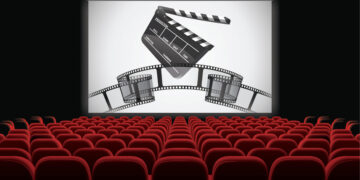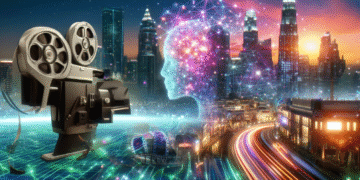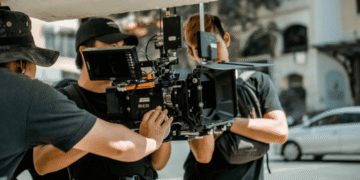The Art of Score Composition: Crafting Emotional Narratives
Film score composition is the subtle yet powerful art of crafting music that amplifies the emotional impact of a film, guiding the audience through the narrative.
1. Understanding the Director’s Vision
A composer must first deeply understand the director’s vision, the film’s themes, and the characters’ emotional arcs. This involves close collaboration and detailed discussions to identify the desired mood and atmosphere for each scene. For instance, a suspenseful thriller might require dissonant chords and rapidly changing tempos, while a romantic comedy could benefit from lighthearted melodies and playful orchestrations. The composer’s role is to translate these abstract concepts into a tangible musical language.
2. Developing a Thematic Approach
Many film scores utilize leitmotifs, recurring musical themes associated with specific characters, places, or ideas. This helps to create a sense of unity and coherence throughout the film. A well-developed thematic approach can subtly reinforce the narrative and deepen the audience’s emotional connection to the story. The composer carefully crafts these themes, considering their potential for variation and development as the story unfolds.
3. Balancing Music and Dialogue
One of the biggest challenges in film score composition is finding the right balance between music and dialogue. The music should enhance the scene without overpowering the spoken words or drawing undue attention to itself. This requires careful attention to dynamics, orchestration, and the overall texture of the score. A skilled composer knows when to let the music take center stage and when to recede into the background, allowing the dialogue to shine.
4. Utilizing Orchestration and Instrumentation
The choice of instruments and their arrangement, known as orchestration, plays a crucial role in shaping the emotional impact of a film score. A string section can evoke feelings of romance or sadness, while brass instruments can convey power and heroism. The composer carefully selects instruments and arranges them in a way that complements the visuals and enhances the emotional impact of each scene.
Soundtrack Albums: Bridging the Gap Between Film and Music
Soundtrack albums serve as a potent bridge, allowing audiences to relive cinematic moments through music and discover scores as standalone artistic expressions. They extend the life of a film beyond the screen.
1. The Evolution of Soundtrack Albums
Initially, soundtrack albums were primarily orchestral scores. However, they evolved to include popular songs featured in films, often becoming significant promotional tools. The rise of artists creating original songs specifically for films further blurred the lines, creating diverse and commercially successful soundtrack albums. This evolution reflects changing tastes and the increasing integration of music in film narrative.
2. The Impact on Film Promotion
Soundtrack albums act as powerful marketing tools. Hit songs from soundtracks frequently receive radio airplay, generating buzz and attracting audiences to the film. The success of a soundtrack can significantly boost a film’s popularity and box office revenue, creating a symbiotic relationship between the music and film industries. This impact showcases the marketing potential of combining visual and auditory experiences.
3. Artistic Merit and Recognition
Beyond their promotional value, soundtrack albums are increasingly recognized for their artistic merit. Composers are gaining wider recognition for their contributions to film, with awards and critical acclaim acknowledging the artistry involved in creating effective and evocative scores. The soundtrack album allows listeners to appreciate the nuances and complexities of film music in a different context.
Music Licensing: Navigating Legalities in Film Production
Securing the rights to use existing music in a film is a critical, yet often complex, part of the filmmaking process. Proper licensing avoids legal repercussions and ensures fair compensation for artists.
| Type of License | Rights Granted | Typical Cost Factors |
|---|---|---|
| Synchronization License | Right to synchronize music with visuals | Usage duration, prominence, film budget |
| Master Use License | Right to use the specific recording of a song | Artist popularity, recording rights holder |
| Performance License | Right to publicly perform the music | Venue size, number of attendees |
1. Understanding Synchronization Licenses
A synchronization license, or “sync” license, grants filmmakers the right to synchronize a musical composition with visual images. This license is obtained from the music publisher, who controls the copyright to the song’s underlying melody and lyrics. The cost of a sync license depends on various factors, including the song’s popularity, how prominently it is featured in the film, and the film’s overall budget.
2. Obtaining Master Use Licenses
In addition to a sync license, filmmakers also need a master use license to use a specific recording of a song. This license is obtained from the record label that owns the copyright to the sound recording. Securing a master use license can sometimes be more challenging than obtaining a sync license, especially if the recording is owned by a major label or if the artist has specific restrictions on how their music can be used.
3. Public Performance Rights
If a film containing copyrighted music is screened publicly, the venue or organization hosting the screening typically needs to obtain public performance licenses from performing rights organizations (PROs) like ASCAP, BMI, and SESAC. These PROs collect royalties on behalf of songwriters and publishers when their music is performed publicly. However, in many instances, the film production company is not directly responsible for securing these licenses.
4. Negotiating License Fees
Negotiating license fees can be a complex process, especially for independent filmmakers with limited budgets. It’s crucial to research comparable license fees for similar uses of music and to be prepared to negotiate with publishers and record labels. Sometimes, filmmakers can negotiate a lower fee by offering screen credit or by agreeing to use the music in a less prominent way.
Diegetic vs. Non-Diegetic Sound: Enhancing Storytelling Through Audio
The strategic use of sound significantly impacts a film’s narrative, shaping audience perception and emotional engagement. Understanding the difference between diegetic and non-diegetic sound is crucial for appreciating cinematic storytelling.
1. Defining Diegetic Sound
Diegetic sound originates from within the film’s story world. Characters can hear it, and it’s part of their reality. Examples include dialogue, the sound of footsteps, a car horn, or music emanating from a radio within the scene. The key characteristic is that the source of the sound is visible on screen or implied to be present in the scene’s environment. Diegetic sound helps create a sense of realism and immerses the audience in the film’s world.
2. Exploring Non-Diegetic Sound
Non-diegetic sound, conversely, comes from outside the story world. Characters cannot hear it. This category typically includes the film’s score, voice-over narration, and sound effects added for dramatic effect. Non-diegetic sound is used to enhance the emotional impact of a scene, provide commentary, or guide the audience’s interpretation of events. It serves as a direct communication from the filmmaker to the viewer, shaping their understanding and emotional response.
3. The Power of Contrast
The interplay between diegetic and non-diegetic sound is a powerful tool for filmmakers. A sudden shift from diegetic sounds to a dramatic non-diegetic score can heighten tension or signal a change in perspective. Similarly, the absence of non-diegetic sound can create a sense of realism or isolation. Skillful manipulation of these sound types allows filmmakers to control the audience’s emotional journey and deepen their engagement with the story.
Q&A
Question 1: What is the primary function of a film score composer, and what key elements do they need to consider during the composition process?
Answer: A film score composer’s main role is to create music that enhances the emotional impact of a film, guiding the audience through the narrative. This requires a deep understanding of the director’s vision, the film’s themes, and characters’ emotional arcs. Key considerations include developing thematic approaches (leitmotifs), balancing music with dialogue, and carefully selecting instrumentation and orchestration to match the scene’s mood and visuals.
Question 2: How have soundtrack albums evolved, and what is their significance in the film industry beyond simply accompanying a movie?
Answer: Soundtrack albums initially featured primarily orchestral scores but have evolved to include popular songs featured in films. They’ve become significant promotional tools, boosting film popularity and box office revenue. The creation of original songs specifically for films further broadened their appeal. Beyond promotion, they are increasingly recognized for their artistic merit, providing a platform for appreciating film music as a standalone art form.
Question 3: What is Foley sound, and how does it contribute to cinematic realism and emotional depth?
Answer: Foley sound is the reproduction of everyday sounds for filmmaking, meticulously recreating sounds to synchronize with on-screen actions. It enhances realism by adding details that might be missing from original recordings. Beyond action sounds, Foley creates atmosphere and environment (e.g., rustling leaves, creaking doors), and adds emotional depth by amplifying subtle sounds that enhance character emotions (e.g., trembling hands).
Question 4: What are the different types of music licenses needed for film production, and why is securing these licenses crucial?
Answer: Filmmakers need synchronization licenses (to synchronize music with visuals), master use licenses (to use a specific recording), and potentially public performance licenses (for public screenings). Securing these licenses is crucial to avoid legal repercussions and ensure fair compensation to artists and copyright holders. Negotiating license fees can be complex, especially for independent filmmakers.






